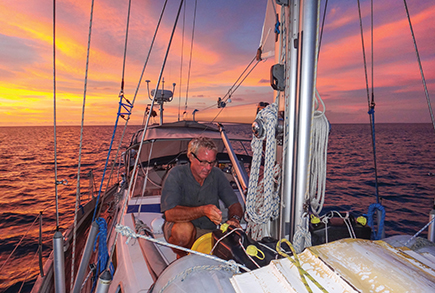Tenaya shares the seas with flying friends while heading from PNG to Palau (published February 2015)
Maybe the sky knows this is our last night in Papua New Guinea. It shoots ribbons of brilliant pink, yellow and orange across the evening sky and makes leaving the beauty, people and culture of these remote islands more difficult. Jim and I will head out in the morning to Palau, 955 nautical miles northwest—back into the Pacific, across the equator and into a typhoon zone.
Typhoons form east of Palau and strengthen as they travel west toward the Philippines. The passage should take about eight days and we need to time it between systems. Japanese and American weather sites and Commander’s Weather all agree we should leave now.
AN EVENTFUL BEGINNING
Dark clouds loom as we set off in light winds. Once we’ve cleared the pass through the reef, a squall unleashes a torrent of rain and 25 knots of wind. It is over in four minutes. For three hours we dodge and are hit by more squalls. Just before sunset the sky clears so we rig the sails wing-and-wing and sit back to enjoy. Lightning dances in the distance, stars shine above.
At 2258 on October 1 we cross the equator. Tenaya is in the Northern Hemisphere for the first time in three years. We have come close to two big ships and a third calls Jim on the radio just to chat.
Later we sail close to a 500-gallon steel drum painted red with white letters and numbers. There are no lights. Jim writes “scary” in the logbook. Hitting one of these Fish Aggregating Devices (FADs) at night would not be good.
The wind was forecast to be light so we are on the rhumbline to Palau. On October 2 at 1600 it kicks up to 15 knots from the south and we have wonderful sailing on a broad reach. At 2011 another cargo ship passes, its Closest Point of Approach (CPA) is one mile. Just then a squall hits with winds over 25 knots. In an hour it is gone and we are motoring. It goes on like that all night. At 0442 we are in the middle of an intense squall and decide to heave to and let it pass. Tenaya drifts south-southeast at three knots for three hours, negating pretty much all the progress we’d made in the previous three hours.
We realize it is not a squall, though. The weather has changed. The wind is coming from the west, exactly where we need to go. It has strengthened to the high 30s with gusts over 40. Another typhoon has formed. We are at 140E and need to get to 135E. We tack into the wind but get nowhere. There is a one to two knot current against us. We try motorsailing but, at 1200 rpms to conserve fuel, make no progress. The sky is dark with clouds and rain.
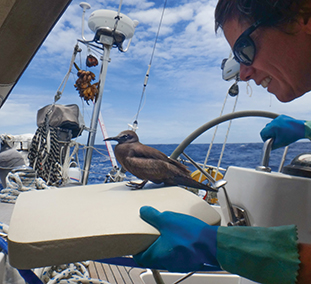
OUR FIRST FRIEND
A booby circles the boat and a juvenile brown noddy lands. He hops into the cockpit and then onto the cushion under the enclosure Jim stitched. He looks bedraggled and eyes me as if to say, “you are warm and rested so let me have that dry corner.” He inches up next to me and tries to hop up on my lap. I don’t let him.
The noddy keeps me company during my watch. We chatter and grumble and each time I stand up he steals my spot. He drinks the water I squirt from my bottle and stays with us for more than a day. Every few hours Jim or I write “bird still here” in the log.
We cannot make progress and are losing ground. A friend watching the weather sites tells us it is calm where we are, the weather we are experiencing is really 120 miles north. We give up trying to go west and turn south, away from the storm. Our friend berates our decision and thinks we should stay put, let it pass, then carry on. We worry about running out of fuel.
At 0400 on October 4 we cross the equator again and are back in the Southern Hemisphere. I contact other voyagers for information about Vanimo, the westernmost port of entry in PNG. One suggests going to Jayapura, Indonesia instead. It is a bigger city with less safety issues and is further west. West is good.
By 1000 the next day the sky has cleared and the sea has mellowed. We’re sailing on a beam reach and the current is with us. I put the noddy out on deck and when I look again he is gone. I hope he has flown away and not gone overboard.
ONWARD TO JAYAPURA

In the calmer conditions we have a look around Tenaya. Jim goes to the mast to coil a halyard and notices the boom sitting funny. The pin has worked loose. The small retaining post to keep it in place is missing. Should it come out completely, the boom will bang around and break something, so we roll in the mainsail. Jim removes the pin and lashes the boom to the mast. He has a plan to repair it using another pin. It is too long but he can shim it up with washers. The sea is still bouncy so he decides to wait until we reach Jayapura.
At 0105 on October 5 Jim writes in the log: “Boat off starboard beam. Two white lights. Think I see red light.” When I come on watch at 0200 we are in the middle of a squall. Rain is gusting sideways at 25 knots. Visibility is nil. He tells me about the ship. Normally they show up as a purple radar blip on the chartplotter, but the screen is all purple because of the rain. It does not appear on AIS. He says he called on the radio and was told it would pass behind us. He is not happy that we are cutting in front of a big ship we cannot see. My sleepy stupor vanishes.
The squall subsides enough for us to see the ship’s lights behind us. Jim goes to bed and I settle in for my five hour watch. At 0500 I see lights on shore 33 miles ahead. The sea is smooth and the wind is in the single digits. Jayapura was not our intended destination but we are happy the passage is over.
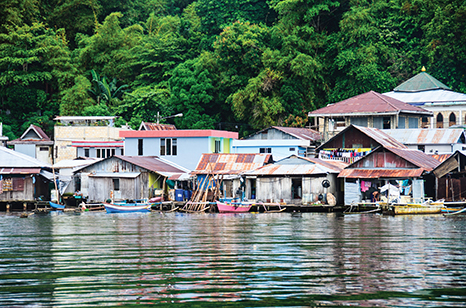
Green mountains surround the expansive bay. There are large wooden trimarans anchored and small motorized outriggers zipping around. People aboard wear hats and their faces are covered, shielded from the blazing sun. There are no other sailboats, no marinas and the only place to anchor is 40 meters deep. Two Coast Guard boats are tied to the wall near the Harbormaster. We motor close and see a man on each. I motion to ask if it is okay to anchor there and the man on the smaller boat signals to tie to his dilapidated boat. Perfect! What could be easier and safer?
The smells of Jayapura assault my nose and it is dirty with plastic bags and bottles piled in the gutters and floating in the bay. It is grimy and crowded but in an interesting and even endearing way. We have been away from civilization for three months and are ready for a city fix. Our broken gooseneck, deemed an emergency, allows for a 30-day visa with the understanding that once it is repaired, we leave. We stretch it out a week waiting for a weather window. The people, and there are a lot of them, are really nice. We don’t want to leave.
Our new Coast Guard and Navy friends wave as we leave Jayapura at 0900 on October 17. Our plan is to sail parallel to the West Papuan coast for about 350 miles until we reach 135E, the longitude of Palau, then go due north for about 500 miles. That way, if another typhoon comes, we can duck into Biak or Manokwari, Indonesia to wait it out.
MORE FRIENDS OF A FEATHER
Hundreds of logs float partially submerged and here and there are big metal drums. Some are painted, others are not. We are happy to have a full moon to help see the bigger hazards. Even so, we feel things bump the hull.
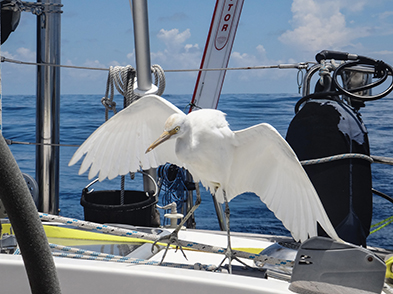
On day three I climb into the cockpit for my 1200 watch. Jim says, “Look out there.” I see a cattle egret! What is he doing 50 miles from shore? He sashays about the boat with his long spindly legs and enormous non-webbed feet looking into the open windscreen, strutting along the deck, peering into the bucket and hopping up onto the combing.
When we change course to head directly to Palau, Jim wonders if we should boot him off so he can find an island. I figure he’ll leave when he wants. That night he hunkers down on the windward side deck. He stays there all night and we cross the equator for the third time while he sleeps.
In the morning he wanders around again. He flaps his wings to hop up on the coachroof but a gust of wind catches him and he’s gone. I look behind but don’t see him. Then I do. He is flying towards the stern. He dips down and tries to land on the windvane but must have fallen off because he is sitting in the water. He rises up and tries to fly to the stern again. This time I slow Tenaya down. “Come on, you can do it, come on,” I urge out loud. He wobbles terribly and tries to land on the windvane again but slips off. This time he just stays on the water. I watch as he grows smaller and then disappears. Jim comes up because he heard the change in the rpms. “What’s up?” he asks. My voice cracks as I tell him.
That night a red-footed booby lands on the pulpit at dusk. He stays all night and flies away at dawn. What a mess he leaves on the bowsprit.
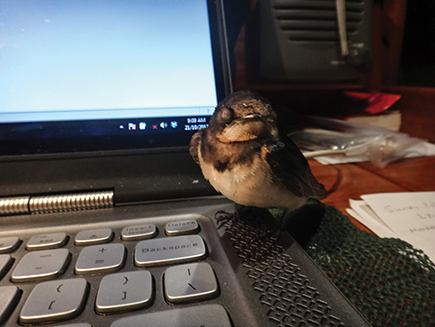
On day five I am sitting at the chart table typing a message when Jim calls down, “Did a little bird just fly down there?” I look around. Nope. I go to hit the backspace key and there he is sitting on the edge of my computer. His eyes are closed.
I grab my camera and take some photos. He doesn’t move. Not wanting him below, I put a small towel in a Tupperware box, ease him inside and set it in the cockpit. He jumps out immediately and hops up to the windscreen, settles onto a flare and sleeps through the night.
In the morning he flies away and returns several times. At one point he is sitting on a lifeline and another bird just like him flies by but does not land. I can’t find them in my Seabirds Identification Guide so perhaps they are land birds. By afternoon I think he’s flown away. There is a squall during the night with heavy rain. As dawn breaks, I find his soggy body lying on the deck. No, I think, not again. I wait until Jim comes on watch at 0700 to measure him. Then I drop him overboard.
On day seven yet another little bird visits. He flies into the cockpit, perches on Jim’s Kindle, looks at him, then flies down inside. He flutters around looking for a place to land and then flies out the smallest window. When he comes back and perches on the same window, I shoo him away. I’ve had enough of dying birds.
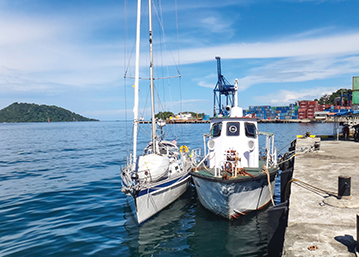
That night we reef the sails to arrive at the pass into Palau in daylight. The current has been against us the entire trip. After clearing in at the Commercial Dock, we motor around Malakal Island and see the first American flag flying on a vessel since we left Sydney. It is on a U.S. warship anchored in the bay. As we round another turn, we see the main anchorage and, finally, other cruising sailboats.
With their floating home stored safely on the hard in Istanbul, Katie and Jim have flown the sailing coop for winter. Skiing, hiking and adjusting to land life in the mountains of California are keeping them busy. They will return to Turkey in April for more sailing adventures aboard Tenaya, their 40 foot Hallberg-Rassy sloop. You can read more about their travels at www.tenayatravels.com.















